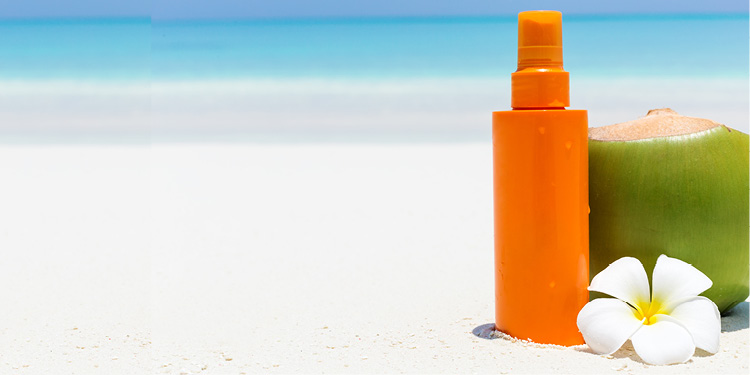


Sign-up for {N}power to get exclusive discounts, newsletters, members-only features, and more!
 Denver - Design District - Alameda and Broadway
Denver - Design District - Alameda and Broadway
368 S Broadway
Denver, CO 80209
United States
 Preferred Store:
Select a Store
Preferred Store:
Select a Store


Most people automatically think of shielding their skin from the sun, but the sun is actually beneficial for our health—in the right doses! Sun on our skin allows our bodies to make vitamin D, which does so many important things for health. Exposure to the sun also improves our mood, supports cardiovascular health by contributing nitric oxide to the body, and may even shrink fat cells![i] When it comes to the skin, however, sun exposure is a different story. Aside from a few skin conditions that are improved by sun exposure, too much sun is no good for our skin. Obviously, there is the concern of sunburn and a risk of skin cancer. But sun damage is also responsible for most of the skin changes we associate with aging, like fine lines and wrinkles, saggy or thin skin, and liver spots (a.k.a. sun spots). So, while it is a good idea to get some sensible sun exposure for general health, it is also a good idea to protect your skin in the process with a simple summer skincare routine.
If you’re looking forward to a summer playing in the sun, but want to avoid a painful sunburn and protect your skin from sun damage, put these three simple skin care steps to work for you and the skin you love!
A powerful, but often overlooked approach to protect skin from sun damage is to ensure the skin is protected with ample antioxidants to counter the free radicals that are created from UV exposure. These free radicals are not only responsible for sun-induced skin damage, but can also contribute to DNA damage.
Start with a moisturizer rich in free radical scavengers that have been researched for topical sun protection such as vitamin E, vitamin C, beta-carotene, lycopene, astaxanthin, and epigallocatechin gallate (EGCG) found in green tea. If you’re the do-it-yourself type, try this fabulous Pre-Sun Matcha Moisturizer. This recipe starts with a base of skin-loving coconut oil then adds the free radical scavengers vitamin E and green tea, and it is quick and easy to make!
For added benefit, be sure to get lots of antioxidants from your diet by eating ample amounts of fruits and vegetables and by taking one or more of the following skin-loving free radical scavenging supplements: vitamin E, beta-carotene, astaxanthin, lycopene, and/or Pycnogenol®.
This step is especially important for anyone who will be spending an extended amount of time outside because while a little sun won’t do much damage, sunburn and extensive UV exposure will. For those who are already experiencing the outward effects of sun damage, like wrinkles and sun spots, you might want to consider making a sunblock part of your daily skin care routine to prevent further damage. After you’ve applied your free radical scavenging pre-sun moisturizer apply a mineral-based sunblock, which blocks both UVA and UVB rays without relying on endocrine-disrupting chemicals. These sunblocks use titanium dioxide and zinc oxide to physically block UV rays instead of chemicals like oxybenzone, octinoxate, and homosalate. These chemicals are known endocrine disruptors and they may also increase free radical damage in the skin—one of the things you’re trying to protect against! Besides being bad for you, chemical sunscreens also interfere with the endocrine function of fish and marine animals they come in contact with and contribute to the bleaching of coral reefs. To learn more about why mineral-based sunscreens are superior to chemical ones, check out this article. And be sure to apply your mineral-based sunscreen generously to all exposed skin and reapply after sweating or swimming.
It’s easy to forget that how we treat our skin after we’ve been in the sun is an important step for protecting against sun damage. This easy do-it-yourself Post-Sun Aloe Vera Spray is a great way to show your skin some after-sun love, especially if you’ve gotten a bit too much. It contains witch hazel and aloe, both of which are known to be cooling and healing to the sun-exposed skin. It also contains green tea and rosehip seed oil, which is an excellent source of vitamin C. The peppermint essential oil is cooling and the lavender essential oil is well known for a soothing burned skin.
Even if you’ve protected your skin well, sun exposure can be drying, so a good after sun moisturizer is important. Look for one with free radical scavenging nutrients to help restore the skin. The Pre-Sun Matcha Moisturizer is actually a great after sun moisturizer too. Or, if you’re done with being in the sun for the day, a cream with retinol (a.k.a. vitamin A) can help to prevent the breakdown of collagen and improve cell turnover, improving the overall tone and structure of the skin. [ii] Just be careful to not use retinol products when you’ll be in the sun because they cause sun sensitivity, and don’t forget your mineral sunblock during the day if you’re using them at night.
That’s it! It’s as easy as 1-2-3 to protect your skin from sun damage keeping it healthy and nourished. The hardest part is to be diligent about your sun skincare routine because even just one burn can cause damage. Take the time to swap out your beauty products and get in the habit of using them regularly so this summer, you can have your sun and healthy skin too!
References



Sign-up for {N}power to get exclusive discounts, newsletters, members-only features, and more!
